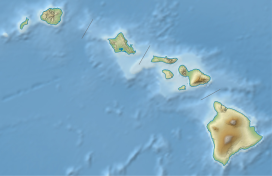| West Maui Volcano | |
|---|---|
| Mauna Kahālāwai | |
 Lihau (center) and Helu (right) peaks | |
| Highest point | |
| Elevation | 5,788 ft (1,764 m) [1] |
| Prominence | 5,668 ft (1,728 m) [1] |
| Coordinates | 20°53′37″N 156°35′22″W / 20.89361°N 156.58944°W |
| Geography | |
| Parent range | Hawaiian Islands |
| Topo map | USGS Kilohana (HI) |
| Geology | |
| Age of rock | 1.32 Mega-annum |
| Mountain type | Much eroded shield volcano |
| Volcanic arc/ belt | Hawaiian-Emperor seamount chain |
| Last eruption | <320,000 years |
The West Maui Mountains, West Maui Volcano, or Mauna Kahālāwai [2] which means "holding house of water," [3] is approximately 1.7 million years old [4] and forms a much eroded shield volcano that constitutes the western quarter of Maui. Since its last eruption approximately 320,000 years ago, the West Maui Mountains have undergone substantial stream erosion. [5] ʻĪao Valley, a popular attraction within the West Maui Mountains, is accessible from Wailuku.
The three moku (districts) of West Maui are Lahaina, Kāʻanapali, and Wailuku. [6] Wailuku is also known as "Pūʻalikomohana" ("west isthmus"), or "Nā Wai ʻEhā" ("the four waters"). The port of Lahaina lies on the southwestern slope.
The summit peak at 5,788 feet (1,764 m) elevation is called " Puʻu Kukui," and its name translates to "candlenut hill". [7]
Puʻu Kukui Watershed Preserve
Established in 1988, the Puʻu Kukui Preserve is the largest private nature preserve in the State of Hawaii. Since 1994, the 8,661-acre (35.05 km2) preserve has been managed by Maui Land & Pineapple Company in participation with The Nature Conservancy and the State Natural Area Partnership. These groups work together to protect the watershed lands of the West Maui mountain.
Geological history
The West Maui Mountains were formed through at least three series of major volcanic eruptions during its shield building period. [5] Rocks from the latest major shield-building eruptions are called the Honolua volcanic series, which are roughly 500,000 years old. However, there were several rejuvenated stage eruptions more recently, the last dating to roughly 320,000 years ago. [5] Though eruptions may have recently occurred as little as 25,000 years ago. [8]
References
- ^ a b "Puu Kukui, Hawaii". Peakbagger.com. Retrieved 10 August 2014.
- ^ "Keawala'i Congregational Church, Kahu's Mana'o". www.keawalai.org. Retrieved 2019-01-24.
- ^ "Hawaii". Elope Maui. Retrieved 2019-01-24.
- ^ Basic Manual for Hawai'i's Tour Drivers/Guides v-6
- ^ a b c Sinton, John M. "Geologic History of Maui" (PDF). Hawaii Institute of Geophysics. Retrieved 18 August 2012.
- ^ "Native Hawaiian Land Division". Haleakalā National Park. U.S. National Park Service.
- ^ Pukui, Mary Kawena; Elbert, Samuel H.; Mookini, Esther T. (1974). Place Names of Hawaii. University of Hawaii. p. 200.
- ^ "Global Volcanism Program | West Maui". Smithsonian Institution | Global Volcanism Program. Retrieved 2023-01-07.
External links
-
 Media related to
West Maui Mountains at Wikimedia Commons
Media related to
West Maui Mountains at Wikimedia Commons - Puʻu Kukui Watershed Preserve
- "West Maui". Global Volcanism Program. Smithsonian Institution.


